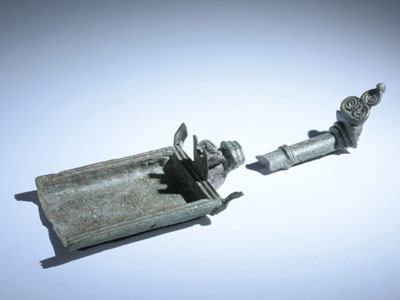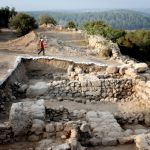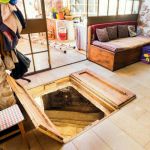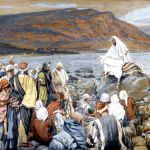“You shall make the altar of acacia wood. … You shall make its pails for removing its ashes, and its shovels and its basins and its forks and its firepans; you shall make all its utensils of bronze.” (Exodus 27:1, 3)
An ancient jug and a bronze incense shovel, implements perhaps made for service in the Holy Temple, have been discovered during official excavations on the shore of Migdal (Magdala in Latin), a Jewish town on the northwest bank of the Sea of Galilee. They have been dated to the time of Yeshua (Jesus) and Roman rule.
Describing the tools as “a rare and exciting find,” Avshalom-Gorni said, “The incense shovel that was found is one of ten others that are known in the country from the Second Temple period.”
“We know that these are certainly sacred tools, perhaps pertaining to the local synagogue discovered on the site, a synagogue which was quite grand and rich and important in the region,” Israel Antiquities Authority (IAA) chief archaeologist Dina Avshalom-Gorni told to Tazpit Press Service (TPS).
“These implements might have been saved in the storeroom as heirlooms by a Jewish family living at Magdala — or they may have been used for daily work, as well,” the archaeologist suggests, after describing them to be found buried next to each other in a seaside storeroom.
In Exodus 27:1–3, God commands that the implements of the Temple altar be made out of bronze, which indicates the shovel’s possible use in the Second Temple.
While Yeshua taught at the Temple in Jerusalem (Matthew 25:55), in the Temple’s Holy Place a “pure, fragrant incense” would burn with flour and oil on an altar of acacia wood “as a memorial portion on the altar, a food offering, an aroma pleasing to the Lord.” (Exodus 37:29; Leviticus 2:2)
Like the decorated, palm-sized shovel that has been found in Migdal, a bronze spade would have been used to move hot coals or ash aside.
Avshalom-Gorni and Arfan Najar, co-overseers of the Migdal excavation site, work alongside Dr. Marcela Zapata-Meza, their partner archaeologist from the Anahuac University of Mexico. After a 2010 invitation from the IAA, Zapata-Meza traveled to Israel and has been investigating the ancient mikvaot [ritual baths] of Migdal, publishing her insights on these as well as on the town’s “domestic and mercantile areas.”
The Migdal dig also led to the discovery of roads, a marketplace, and various industrial areas. Yeshua spent much time ministering in the Galilee, possibly visiting Migdal — whose ancient synagogue was found in 2009 to have the “Magdala Stone,” which has a carving of the Second Temple within a seven-branched menorah on one of its sides.
According to New York Times writer Isabel Kershner, “What makes the [Magdala] stone such a rare find in biblical archaeology, according to scholars, is that when it was carved, the Second Temple still stood in Jerusalem for the carver to see.”
The IAA also found a mosaic-floored synagogue at Migdal.
“We began exploratory digs in 2009 and little by little it became evident to us and to the Catholic Church that we have discovered a major site which was dated to the exact time of the ministry of [Yeshua] Jesus in the Galilee, and the home of Mary Magdalene,” said Avshalom-Gorni to TPS, stating that the land is owned by a private developer from the Catholic Church, “who planned to build a hotel for pilgrims” there. (BIN)







